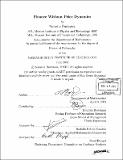| dc.contributor.advisor | Dimitris Bertsimas. | en_US |
| dc.contributor.author | Bushueva, Natasha. | en_US |
| dc.contributor.other | Massachusetts Institute of Technology. Dept. of Mathematics. | en_US |
| dc.date.accessioned | 2005-10-14T20:00:16Z | |
| dc.date.available | 2005-10-14T20:00:16Z | |
| dc.date.copyright | 2003 | en_US |
| dc.date.issued | 2003 | en_US |
| dc.identifier.uri | http://hdl.handle.net/1721.1/29349 | |
| dc.description | Thesis (Ph. D.)--Massachusetts Institute of Technology, Dept. of Mathematics, 2003. | en_US |
| dc.description | Includes bibliographical references (p. 115-118). | en_US |
| dc.description.abstract | Traditional finance theory has addressed portfolio optimization and option pricing problems assuming specific price dynamics for securities. In this thesis we address these problems without assuming specific price dynamics. We consider the problem of determining bounds on the price of an option based on observable prices of other options and the no-arbitrage assumption. This problem has been solved for the case of European options of a single maturity. We find exact bounds on the price of European options, when options of multiple maturities are given. We also find exact bounds if the payoff function on the option is a piecewise linear function of the price of the underlying security. We solve a similar problem in a two dimensional case. The methods developed for two-dimensional case are applicable to the multiple dimensional case, however the number of variables grows exponentially with the dimension. We also investigate how the optimal bounds in the one-dimensional case change, if, in addition to the set of observable prices, there is a condition on the variance of the underlying asset. We derive closed form expressions for the tight upper bound on the variance and propose a polynomial time algorithm for obtaining the lower bound. In the portfolio allocation problem we prove that for large time horizons, there exists a myopic policy which leads to a distribution of the terminal wealth with the property that the probability of underperforming any other policy tends to zero as the horizon tends to infinity. Finally, we address the problem of maximizing a mean-variance function of the terminal wealth in the multiperiod case. For general price dynamics of securities we propose a monte-carlo based method for the solution which is polynomial in the number of securities. | en_US |
| dc.description.statementofresponsibility | by Natasha Bushueva. | en_US |
| dc.format.extent | 118 p. | en_US |
| dc.format.extent | 4314713 bytes | |
| dc.format.extent | 4314520 bytes | |
| dc.format.mimetype | application/pdf | |
| dc.format.mimetype | application/pdf | |
| dc.language.iso | eng | en_US |
| dc.publisher | Massachusetts Institute of Technology | en_US |
| dc.rights | M.I.T. theses are protected by copyright. They may be viewed from this source for any purpose, but reproduction or distribution in any format is prohibited without written permission. See provided URL for inquiries about permission. | en_US |
| dc.rights.uri | http://dspace.mit.edu/handle/1721.1/7582 | |
| dc.subject | Mathematics. | en_US |
| dc.title | Finance without price dynamics | en_US |
| dc.type | Thesis | en_US |
| dc.description.degree | Ph.D. | en_US |
| dc.contributor.department | Massachusetts Institute of Technology. Department of Mathematics | |
| dc.identifier.oclc | 52768553 | en_US |
